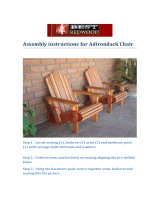
MyOn HC 6
SECTION 1—MAINTENANCE GUIDELINES
Inspect/Adjust Monthly (User or Attendant)
Inspect seat positioning strap for any signs of wear. Ensure buckle latches. Verify hardware that
attaches strap to frame is secure and undamaged. Adjustment/replacement → authorized dealer.
Loosen/tighten locknut if wheel wobbles noticeably or binds to a stop. Adjustment/replacement →
authorized dealer.
Wheel bearings are clean and free of moisture.
Wheel locks do not interfere with tires when rolling.
Wheel lock pivot point are free of wear and looseness.
Ensure all caster/wheel/fork/head tube fasteners are secure (see pages 7 & 34).
Ensure all hardware is tight properly (see page 7). Adjustment/replacement →
authorized dealer.
Ensure hand grips are secure to backrest canes.
Ensure casters are free of debris.
Ensure seat upholstery is adjust properly (see page 16) to obtain a perfect locking of the
folding mechanism. Adjustment/replacement → authorized dealer.
Inspect/Adjust every twelve months (Repairer or Dealer)
Wheelchair rolls straight (no excessive drag or pull to one side).
Arms are secure but easy to release and locking systems engage properly.
Adjustable height arms operate and lock securely.
Armrest arm pad sits flush against arm tube.
All fasteners on clothing guards are secure.
Seat and/or back upholstery have no rips.
Inspect the backrest attaching hardware and mechanisms are securely tightened.
No excessive side movement or binding when rear wheels are lifted and spun.
Inspect handrims for signs of rough edges or peeling finish.
Inspect side frame and folding mechanism for signs of cracks, flaked paint or deformed metal work.
Inspect tires/casters for flat spots and wear.
Check pneumatic tires for proper inflation (recommended tire pressure is listed on
the sidewall of the tire).
Wheel lock pivot point are free of wear and looseness.
Clean upholstery and armrests.
Sealed bearings and axle nut tension are correct.
Wheel/fork assembly has proper tension when caster is spun. Caster should come to
a gradual stop.
Loosen/tighten locknut if wheel wobbles noticeably or binds to a stop.
Wheel bearings are clean and free of moisture.
Wheel locks are easy to engage.
Clean quick-release axles with a Teflon lubricant.
Ensure axles are free from dirt, lint, etc.
Ensure roller bearings are free from dirt, lint, etc.
Adjust wheel brakes as tires wear.
Clean and wax all parts.
Ensure casters are free of debris.






















